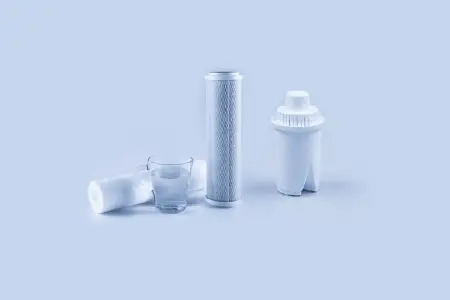Two of the most common technologies in drinking water filtration are carbon-based filters and reverse osmosis, and I get asked a lot on which one is better.
If you’re here expecting a direct answer, I’m sorry to disappoint because there’s no single right choice! While reverse osmosis will remove more contaminants, you also will probably have to remineralize your water.
I hope by the end of this article, you’ll know the difference between carbon water filters and reverse osmosis filters, and you know which one is right for you. So let’s get right to it!
How do carbon filters work?
Carbon filtration sounds like a modern, complex concept, but it’s actually simpler than it seems. In fact, there’s evidence that the Egyptians used activated carbon to purify water as early as 3750 B.C.
Carbon filters, or activated carbon filters as they’re sometimes referred to, work on the basic principle of adsorption – when particles stick to the surface of a medium. The activated carbon filters have a porous surface that removes pollutants by absorbing them into their pores.
Still curious? Here’s a slightly more scientific explanation: activated carbon has a large number of positive ions that attract the negative ions in pollutants and binds it to its surface, letting the filtered water pass through.
The larger the surface area of the filter, the more it will be able to absorb, and the more effective the filtration will be.
What do carbon filters remove?
There are multiple factors that determine how much a carbon filter can filter out. One of them is the filter rating, which can vary between 0.5 microns and 50 microns. The extent of filtering can also vary owing to how many layers of carbon filters are used – in most residential cases, you’ll find that it’s between one and two layers. Here’s a list of contaminants that a good carbon filter can remove:
- Volatile organic compounds (VOCs) and other chemicals, including fuel, oil, solvents, polychlorinated biphenyls (PCBs), radon, dioxins, and even radioactive material.
- Some extent of pesticides and herbicides.
- Disinfectants like chlorine that is used in water treatment but can be harmful if consumed
- Removes the unpleasant odor and bad taste that tap water sometimes has
- Dirt and sediment.
What is not removed by carbon filters?
- Heavy metals like arsenic, lead, nickel, cadmium, mercury, zinc, and cobalt that can be toxin even in small quantities.
- Bacteria and viruses
- Dissolved solids – a carbon filter can only remove about 10-15% of dissolved solids.
How reverse osmosis filters work?
Reverse osmosis (RO) is generally considered the superior water purifying process, simply because it’s much more stringent in what it allows through. RO systems use a thin-film composite (TFC) that pressures the source water through a semipermeable membrane that filters it.
It lets water pass through in one direction while blocking out pretty much anything larger than a water molecule.
RO systems usually comprise multiple layers or stages of purification. There’s a pre-filter that takes care of larger sediments and particulates, then there’s the semi-permeable membrane itself that separates the harmful elements from the water molecules, and, finally, there’s a post-filter that improves the flavor and taste of the water.
Some systems also have a pre-carbon block that does what we just learned about carbon filters – they remove chlorine and other chemicals.
What do reverse osmosis filters remove?
RO filters can remove about 95-99% of pathogens, (bacteria, viruses, etc), salts, and heavy metals, as they can trap pollutants as small as about 0.001 microns – that’s 100,000 times thinner than the width of a strand of hair! Here’s a list of what else they remove:
- Nitrates and salts.
- Heavy metals like copper, lead, mercury, zinc, and cobalt.
- Reduces arsenic
- Reduces mineral content in hard water.
- Organic chemicals like fluoride – sometimes added to tap water.
- Protozoa – Giardia, Cryptosporidium, etc, .
- Viruses – Norovirus, Hepatitis A, Rotavirus, etc.
- Bacteria – Salmonella, Shigella, E. coli, and more.
What is not removed by reverse osmosis?
Reverse osmosis is less effective at removing some of the contaminants that carbon filters do a better job of filtering, such as:
- Organic chemicals like Benzene and Toluene
- Chlorine and Trihalomethanes (THMs)
- Solvents
- Volatile organic chemicals (VOCs)
FAQ
Does a carbon filter remove chlorine?
Yes, a carbon filter can remove chlorine.
Chlorine concentration of more than 0.3 ppm (parts per million) can be tasted in water and an activated carbon filter does a great job at filtering out the chemical. It also filters out trihalomethanes, which are a group of harmful chemicals formed when chlorine and water combine.
Does reverse osmosis remove chlorine?
Yes, reverse osmosis systems do remove chlorine. But keep in mind that chlorine can damage the semi-permeable membrane and destroy it. That’s why it’s recommended that you pre-treat the water with a carbon filter before passing it through an RO system.
How long does a carbon filter last?
Unfortunately, there’s no fixed number I can tell you for this. Carbon filters can last anywhere between 2 and 12 months, depending on the quality of water it filters and the quality of the filter itself.
Like I mentioned earlier, the carbon filters adsorb the contaminants and keep them on their surface in a film called the adsorbate. Eventually, this can seep into the water. And you don’t want that happening.
Your best course of action is to change the filter as per the manufacturer’s recommendations. Also, keep tabs on whether the water starts to smell or taste different, and if there’s a pressure drop – this could mean the filter is starting to get blocked.
Can bacteria grow in RO water?
Yes. The reverse osmosis tank that stores water can act as a breeding ground for heterotrophic bacteria – bacteria that consumes organic carbon. But, don’t worry. Over the last few decades, science has made some serious strides in keeping this in check.
There are easily available sanitation and chemical products that have been designed to kill the bacteria in reverse osmosis systems. Just add it to the tank.
Do carbon filters remove bacteria?
Yes, and no. Let me explain. Bacteria can range between 0.2-10 microns in size and a good quality carbon filter can remove the larger examples. However, this accounts for only a small fraction of bacteria present in tap water. So, for the most part, a carbon filter doesn’t do an adequate job at removing bacteria.
Conclusion
I hope you’ve noticed how both carbon and reverse osmosis filters have their pros and cons.
Carbon filtration removes much less from your water than reverse osmosis, but they are also cheaper.

Nick Lopresti is the founder of YourH2Home and a home improvement expert. He has years of experience writing about various home improvement topics, mostly as it pertains to water systems.
